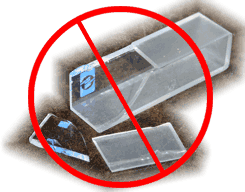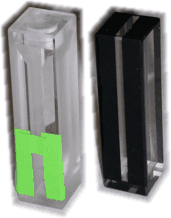|
To make sure that your use of HP8453 is sustainable and enjoyable for you and fellow colleagues, please review and follow several simple guidelines.
Cuvettes
Most measurements in this group involve the use of standard 1cm quartz cuvettes. While seemingly simple, these cuvettes are delicate and precise pieces of equipment. Cost of the most basic cuvette is about $100 while more unique and specialized cuvettes cost several hundred $$ each, not to mention down time it would take to replace them.
Good quartz cuvettes have superior UV transmission. However, they are mechanically fragile and sensitive to contamination. Contaminants on optical surfaces not only will degrade your data, but will lead to degradation of transmission properties thus affecting those who will use cuvettes after you.

The following simple rules must be always followed:
- Cuvettes that are not immediately in use must be stored safely on the shelf in holders – at all times.
- Cuvettes must be washed immediately after use using distilled water and/or solvents and left to dry per #1. - at all times.
- Do not touch optical surfaces. Handle cuvettes by opaque sides or by edges only.
- Clean occasional fingerprints and other contaminations quickly and gently. Do not scrub or scratch.
- Never put cuvettes in the oven or etch with alkali.
- Keep area clean, tippling cuvette over is likely to break it.
 Violation of these rules will lead to problems. Repeat offenders will loose privilege of using spectrometer. Violation of these rules will lead to problems. Repeat offenders will loose privilege of using spectrometer.
|
Lamps
HP8453 uses two lams – tungsten and deuterium as described in Startup and Shutdown. These lamps have finite lifetime and replacement is not available from local hardware store. We can extend their lifetime and minimize maintenance by using lamps wisely.
Naturally, running lamps without use wastes their resources. However, frequent On-Off cycle reduces lifetime as well. Therefore, it is best to plan experiments well and coordinate with other team members. |
Sample size and probe beam
 We have cuvettes of various sizes and geometries to fit the needs of a particular experiment. Whatever cuvette you are using, remember that sample should cover entire probe beam. No part of the beam should bypass the sample on either of four sides. Part of the light that bypasses the sample will cause spectral distortions, especially in the areas with strong absorption. We have cuvettes of various sizes and geometries to fit the needs of a particular experiment. Whatever cuvette you are using, remember that sample should cover entire probe beam. No part of the beam should bypass the sample on either of four sides. Part of the light that bypasses the sample will cause spectral distortions, especially in the areas with strong absorption.
If you sample is smaller than the beam, it is OK to block areas without sample with non-transparent material.
- Some, especially narrow, cuvettes are made with black sides which block unused part of wider beam.
- For cuvettes with clear sides that are only 2-5 mm wide you may need to put small pieces of tape on the sides. Remember to remove tape and wash off adhesive after the experiment.
- If sample volume is limited and not enough to cover beam vertically, consider lifting cuvette in the holder and/or masking top and bottom of the sample.
|
Stirring
 Whenever any reagents are added to the cuvette, a reaction is happening during the measurement, cuvette is thermostated, etc. sample inside the cuvette must be stirred. Stirring ensures that sample composition across the sample beam is uniform and is, indeed, what you would expect. Particularly, sample should be stirred for any time-based measurements. Whenever any reagents are added to the cuvette, a reaction is happening during the measurement, cuvette is thermostated, etc. sample inside the cuvette must be stirred. Stirring ensures that sample composition across the sample beam is uniform and is, indeed, what you would expect. Particularly, sample should be stirred for any time-based measurements.
Sample mixing can be done using pipette that was used for addition of a reagent or by capping the cell and inverting it several times, but these methods are not practical for more than occasional use. HP8453 is equipped with thermostated/stirred cell holder that makes stirring more reliable. Water flow through the base turns a magnet that, in turn, rotates magnetic stirring bar in the cuvette.
 Water circulation used for temperature control is often used to drive stirring as well. In our group, we use a closed water loop with a pump to drive stirring. This provides more flexible control over stirring and allows to keep water bath off when temperature control is not needed. Water circulation used for temperature control is often used to drive stirring as well. In our group, we use a closed water loop with a pump to drive stirring. This provides more flexible control over stirring and allows to keep water bath off when temperature control is not needed.
To turn on stirring, flip switch to Control position (left) and turn the knob to adjust speed. It is best not turn pump to Line because of excessive speed. Pump may get hot and water warm if running at high rate for a long time. In such cases, consider turning on cooling water circulation to keep sample from warming up.
|
Network and data storage
The nickname for HP8453 and the computer that operates it is HPSpec. HP8453 uses Ethernet connection to communicate to computer, but this is a dedicated connection and is not visible from the outside.
While using HPSpec it is convenient to store data on the local hard drive. To keep track of your data files, create a folder under Users folder and temporarily store your data there. The folder name may be your name or a project that you are working on, however, avoid creating multitude of subfolders under Users folder because other users will have to sift through them too.
Do not store data under My Documents – this will lead to a mess in data because spectrometer is used under general login name.
After experiment is finished, take time to move data from local hard drive to RAID-protected UserStorage folder on Phenol. Among many benefits of storing all you data centrally discussed more in Network, remember that many instruments are ran by older computers with higher probability of hard drive failure – a.k.a data loss. |
|



